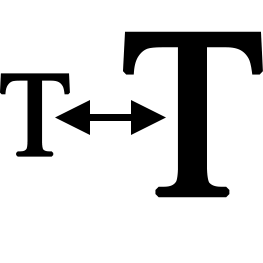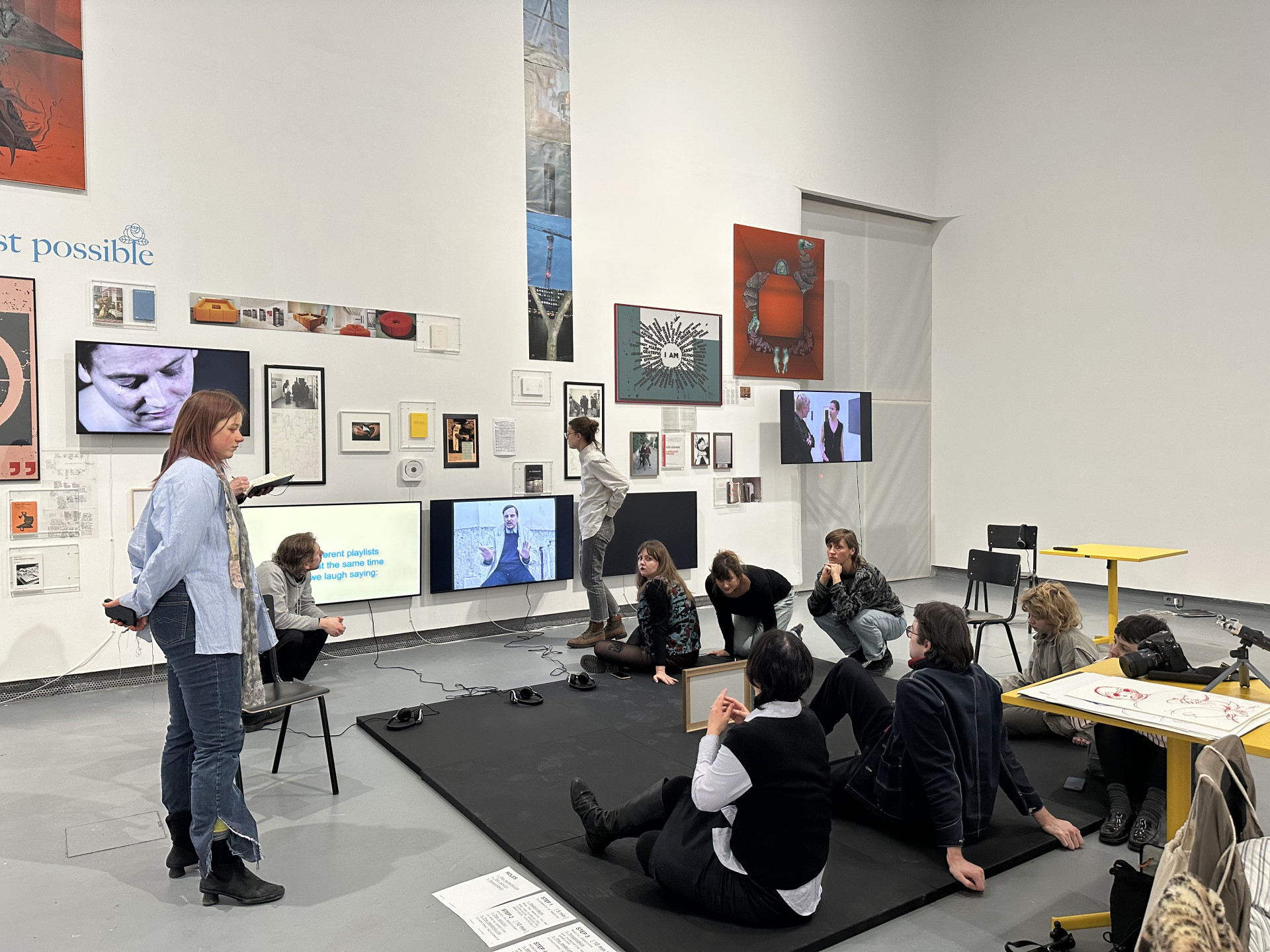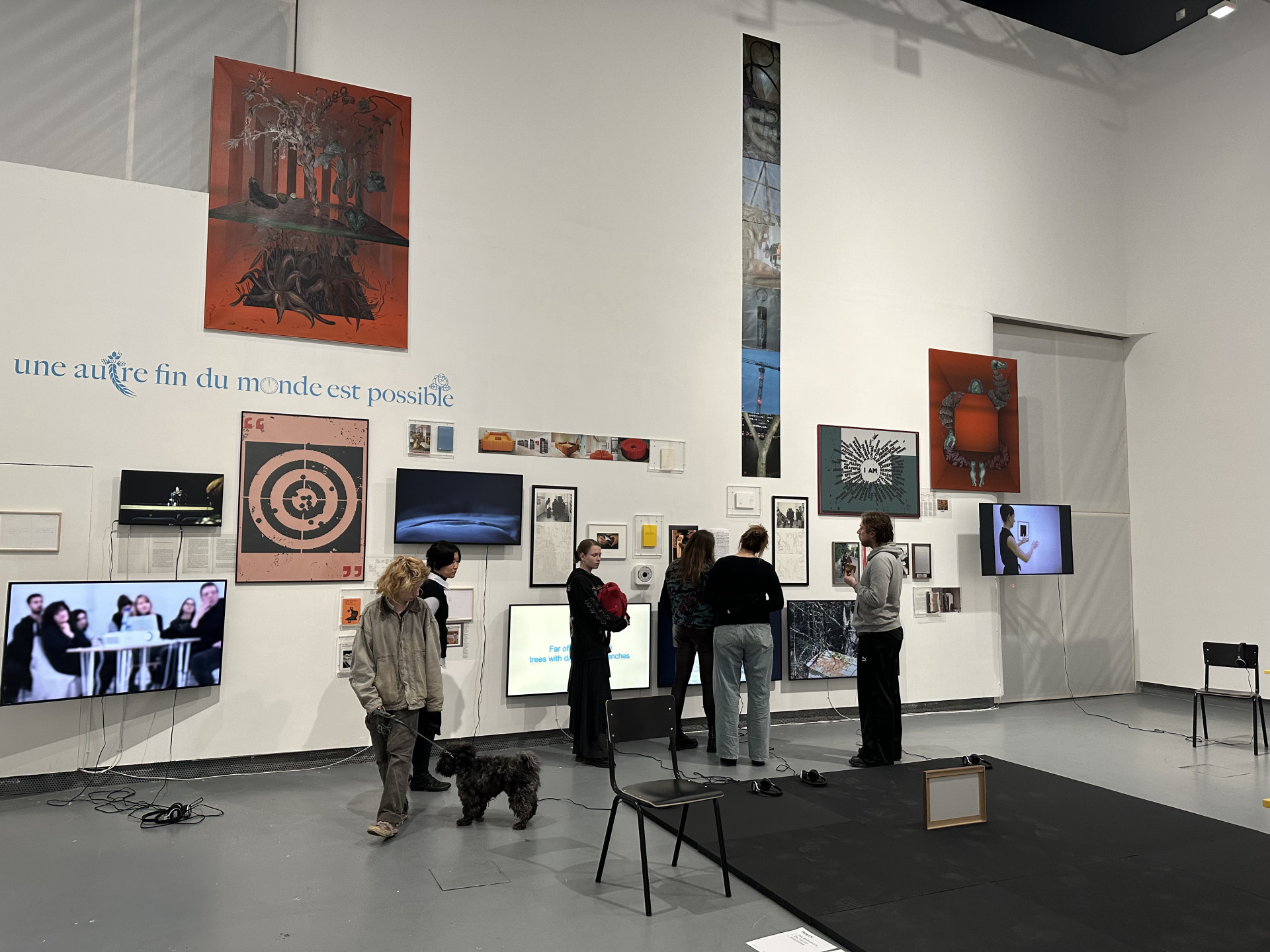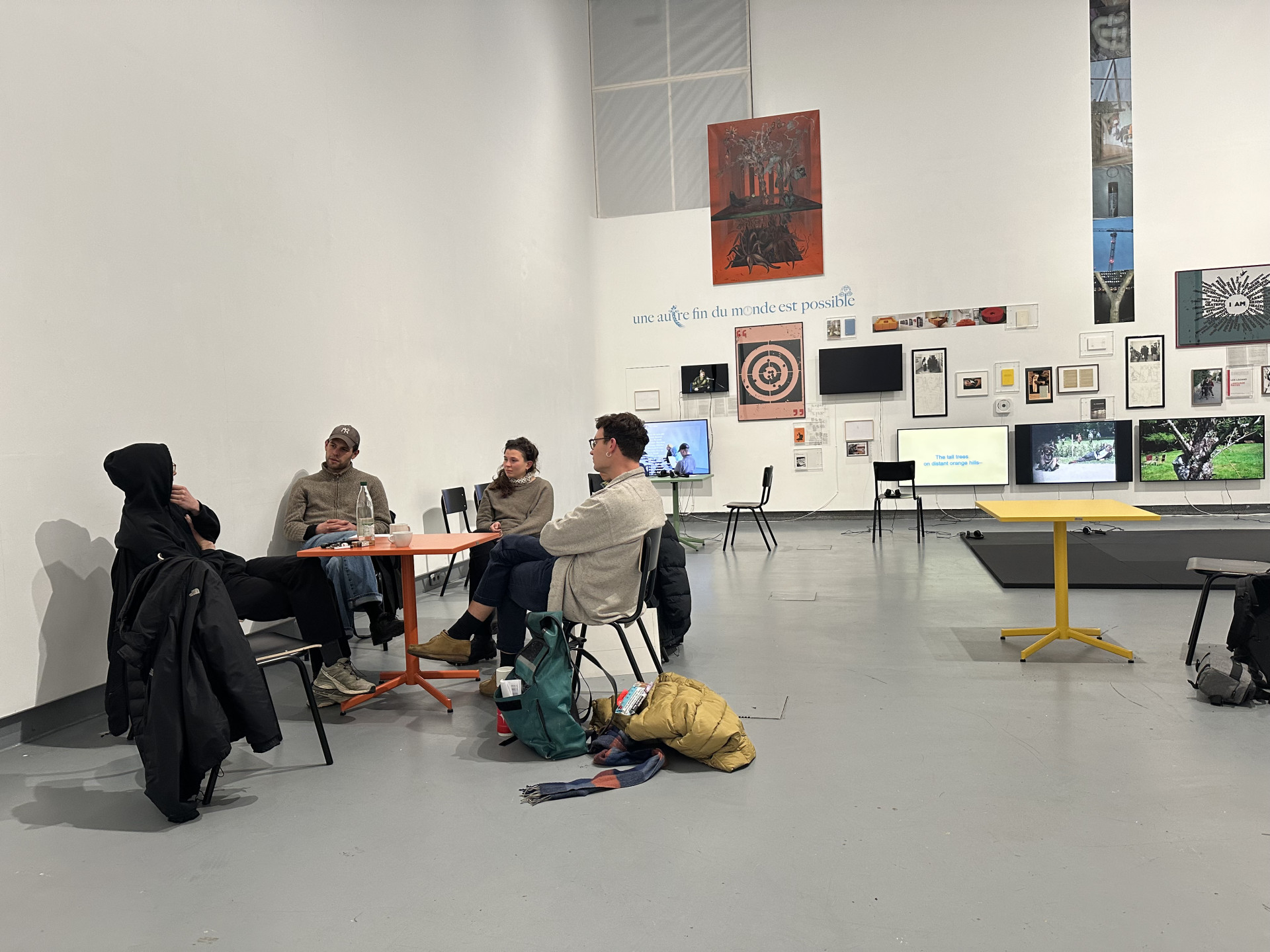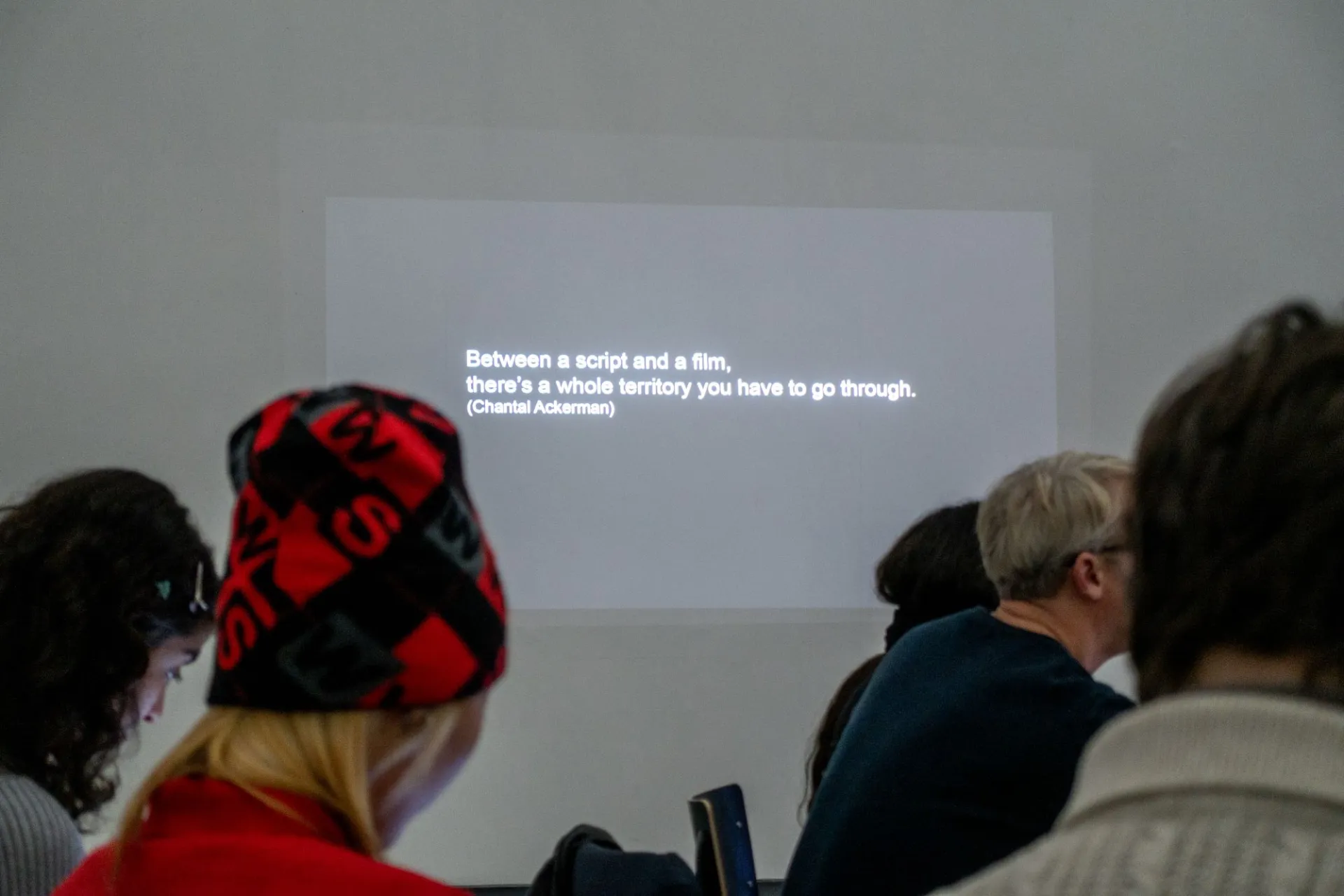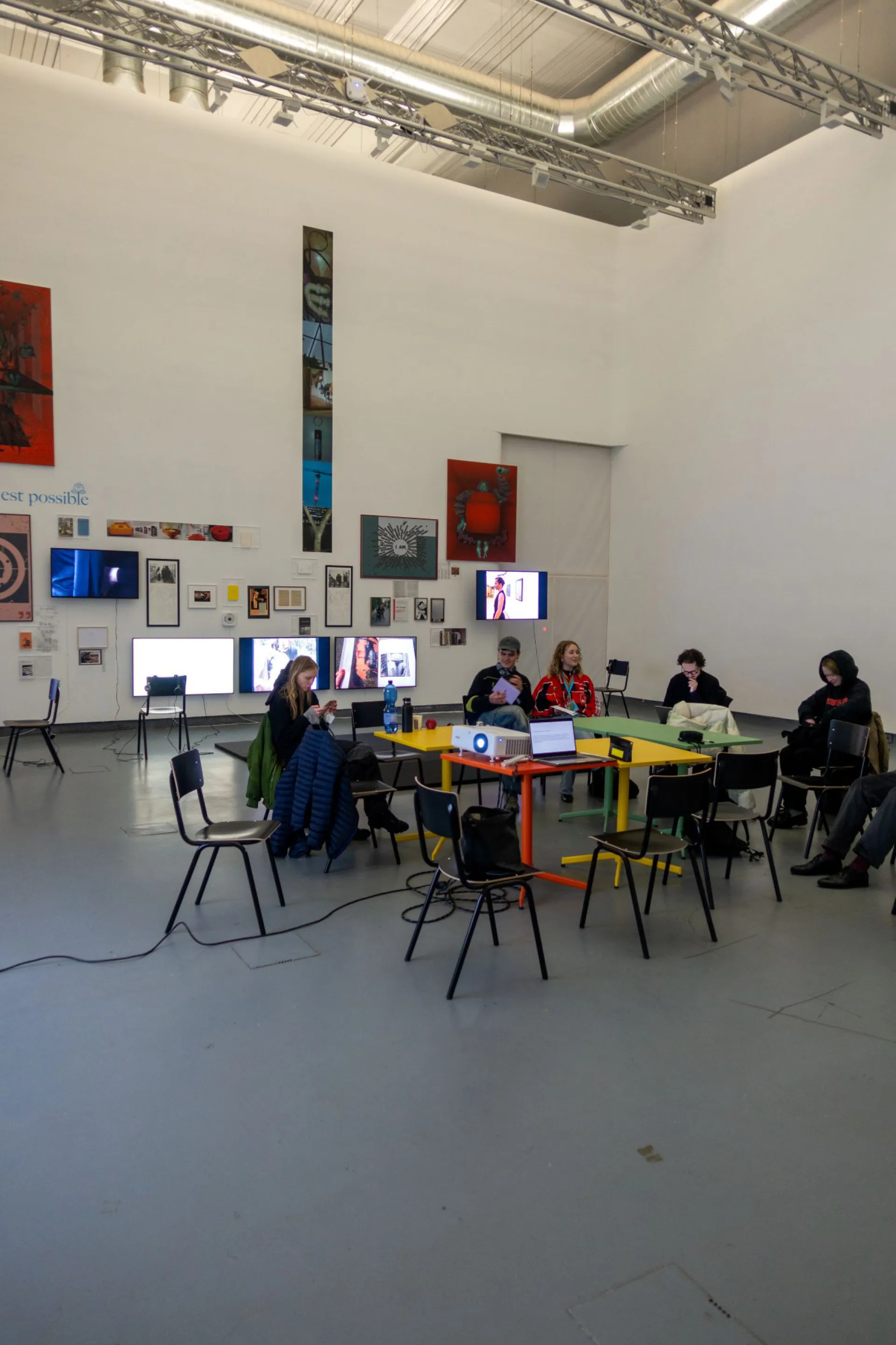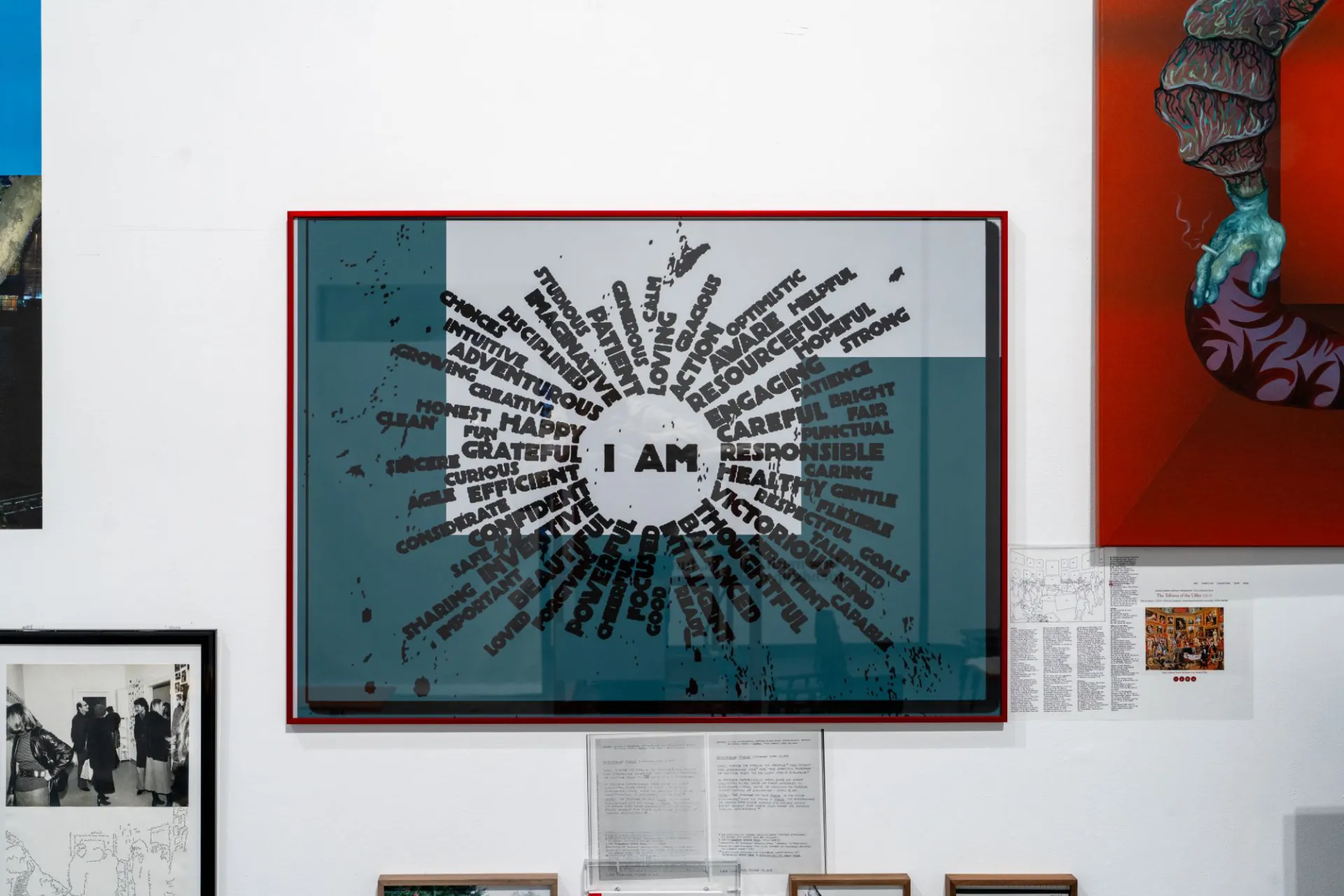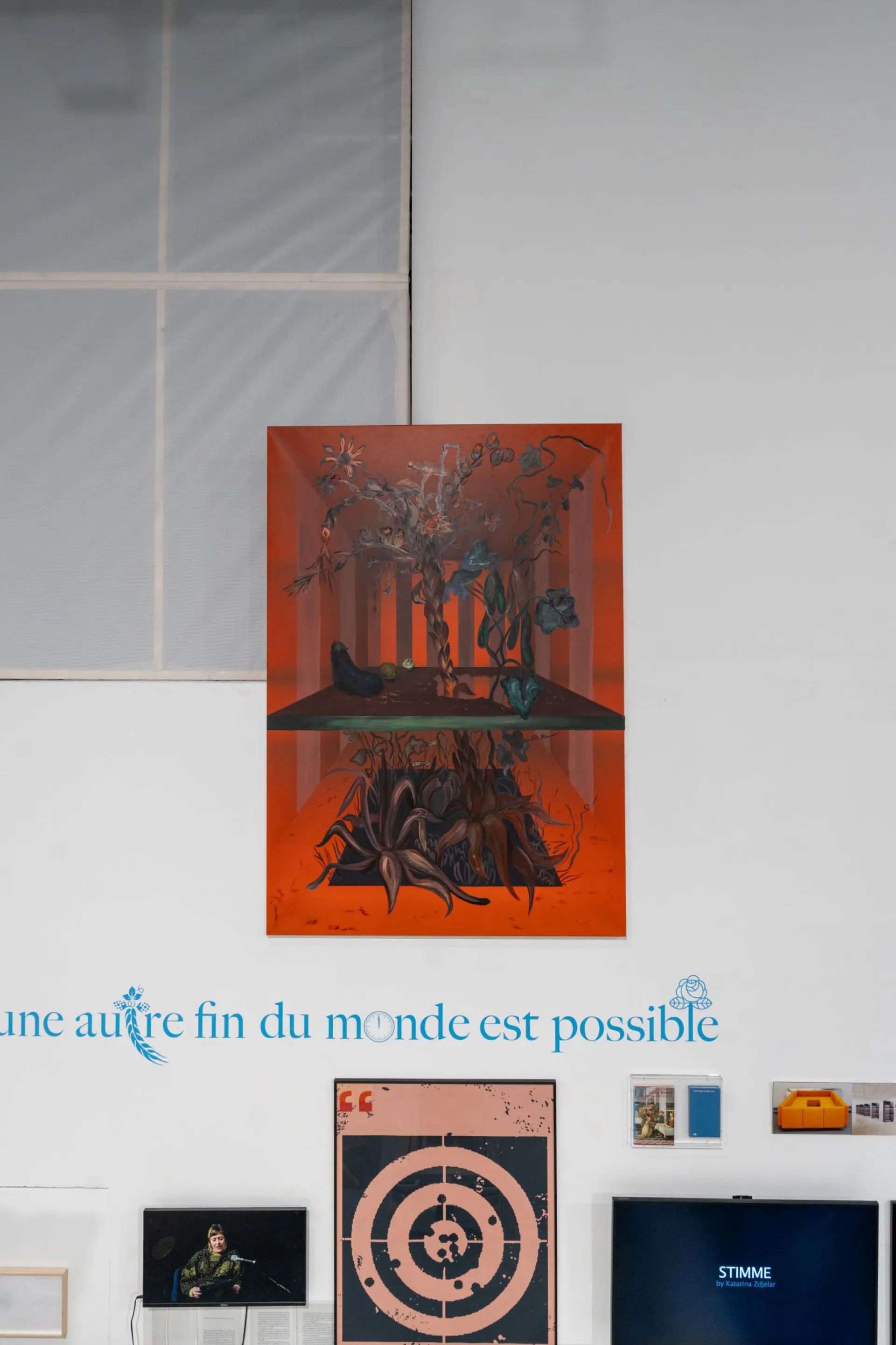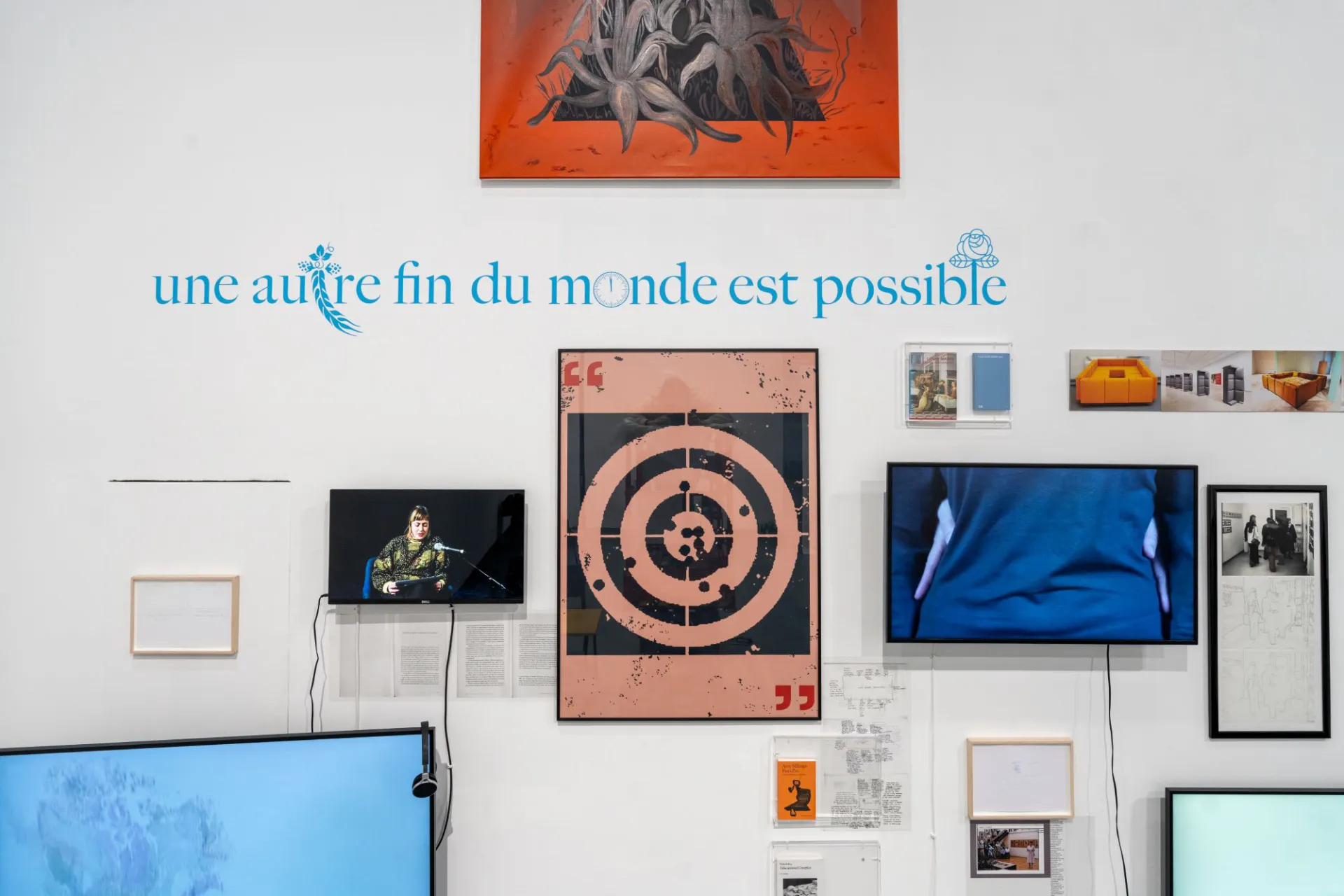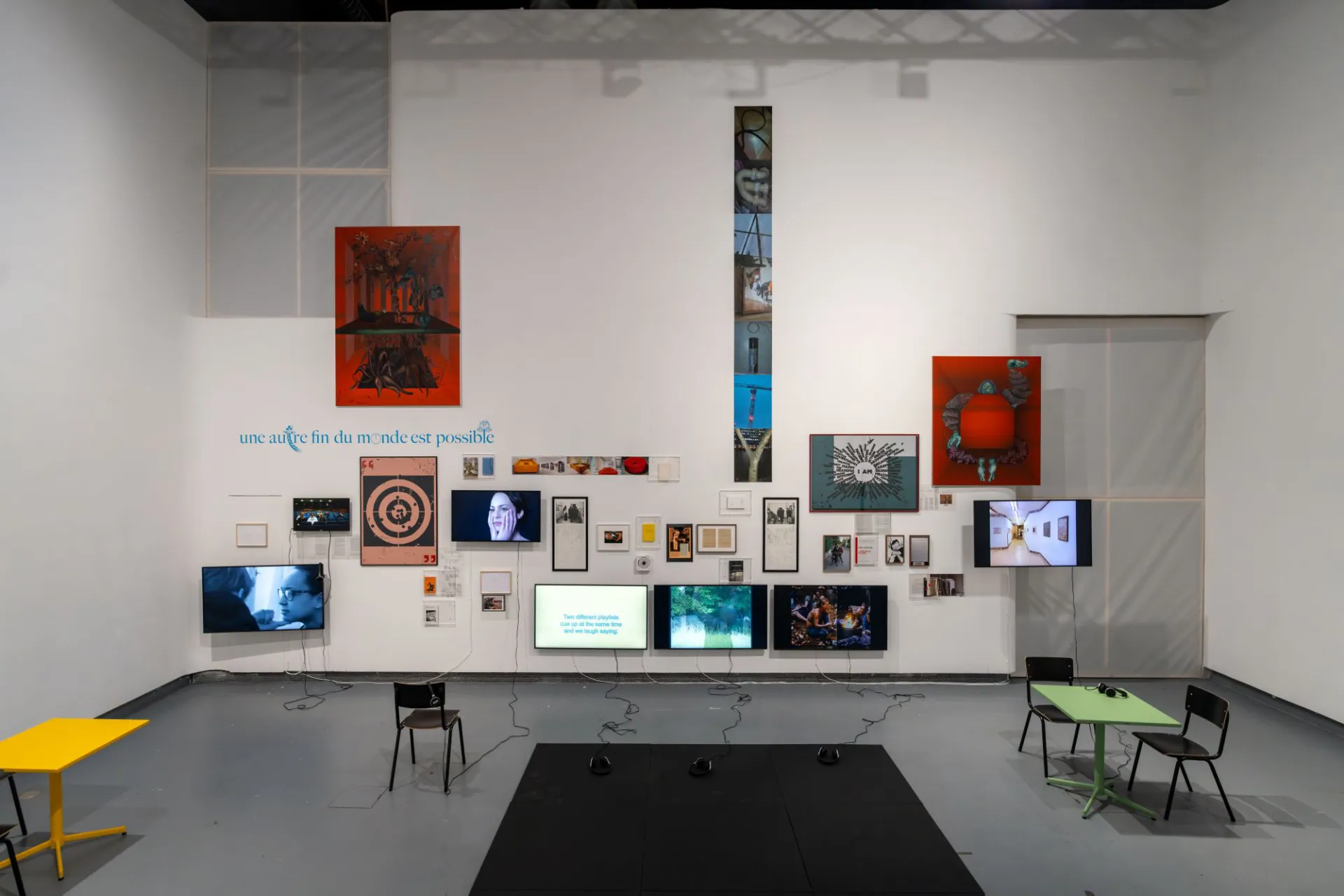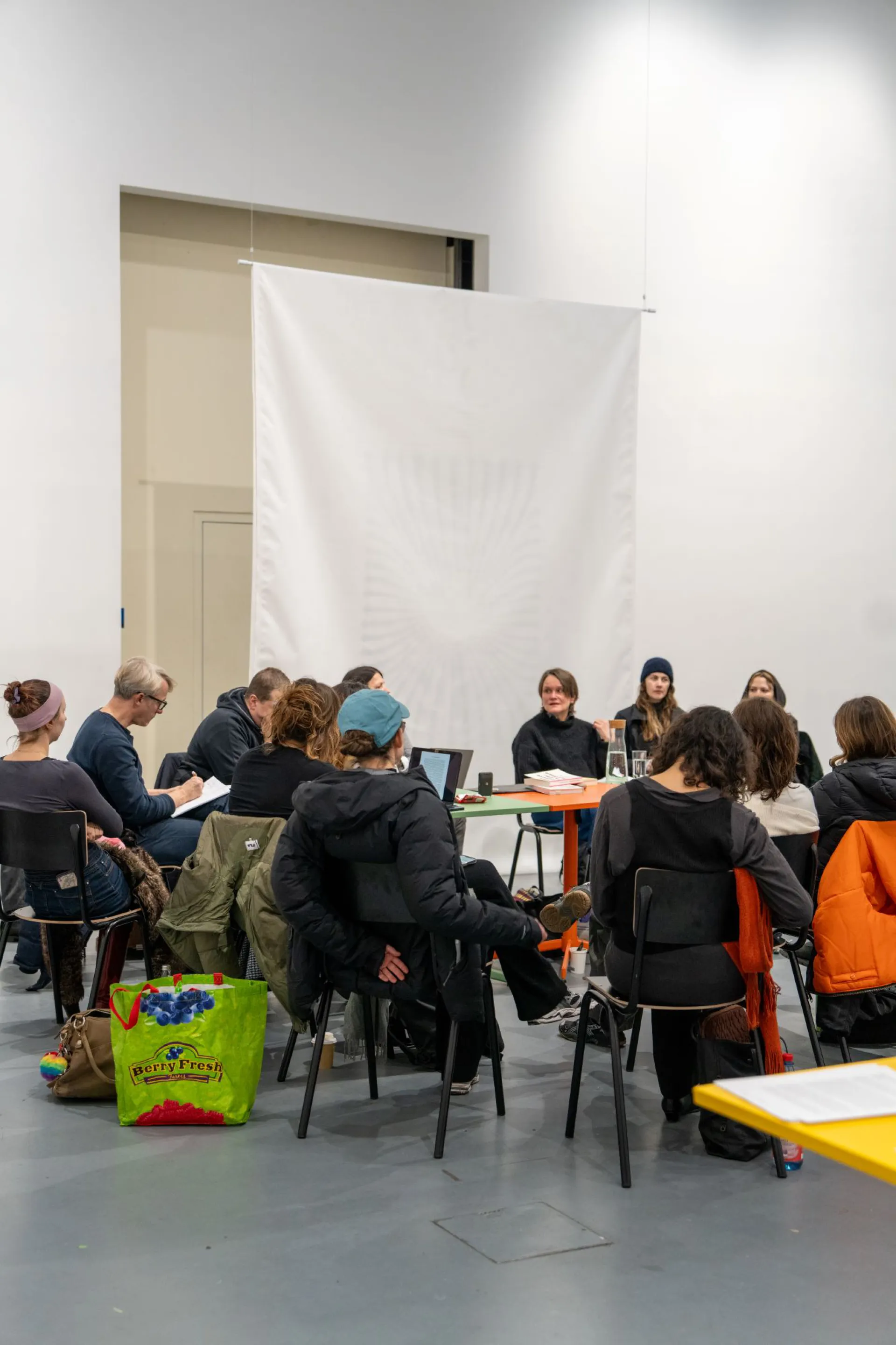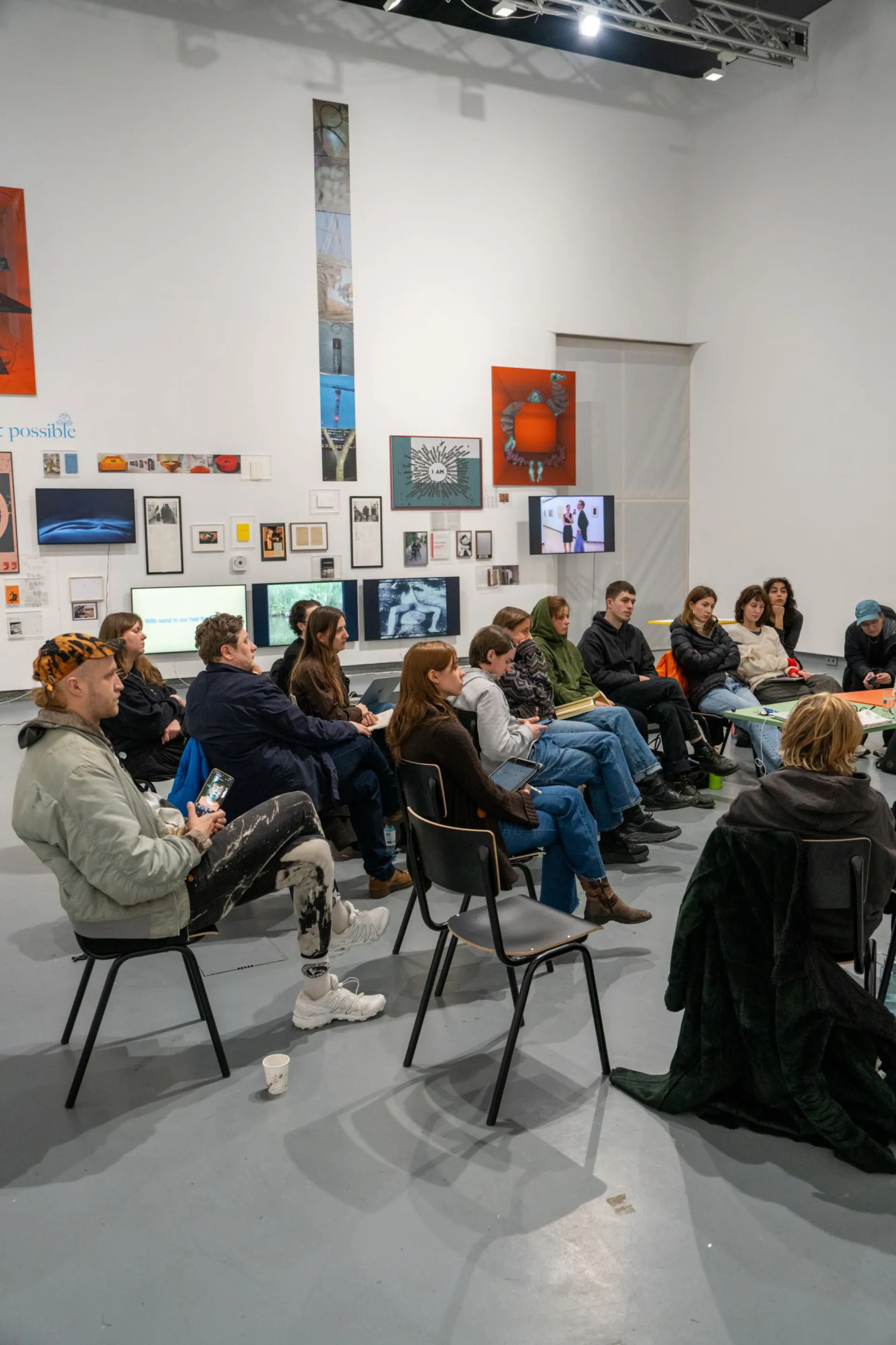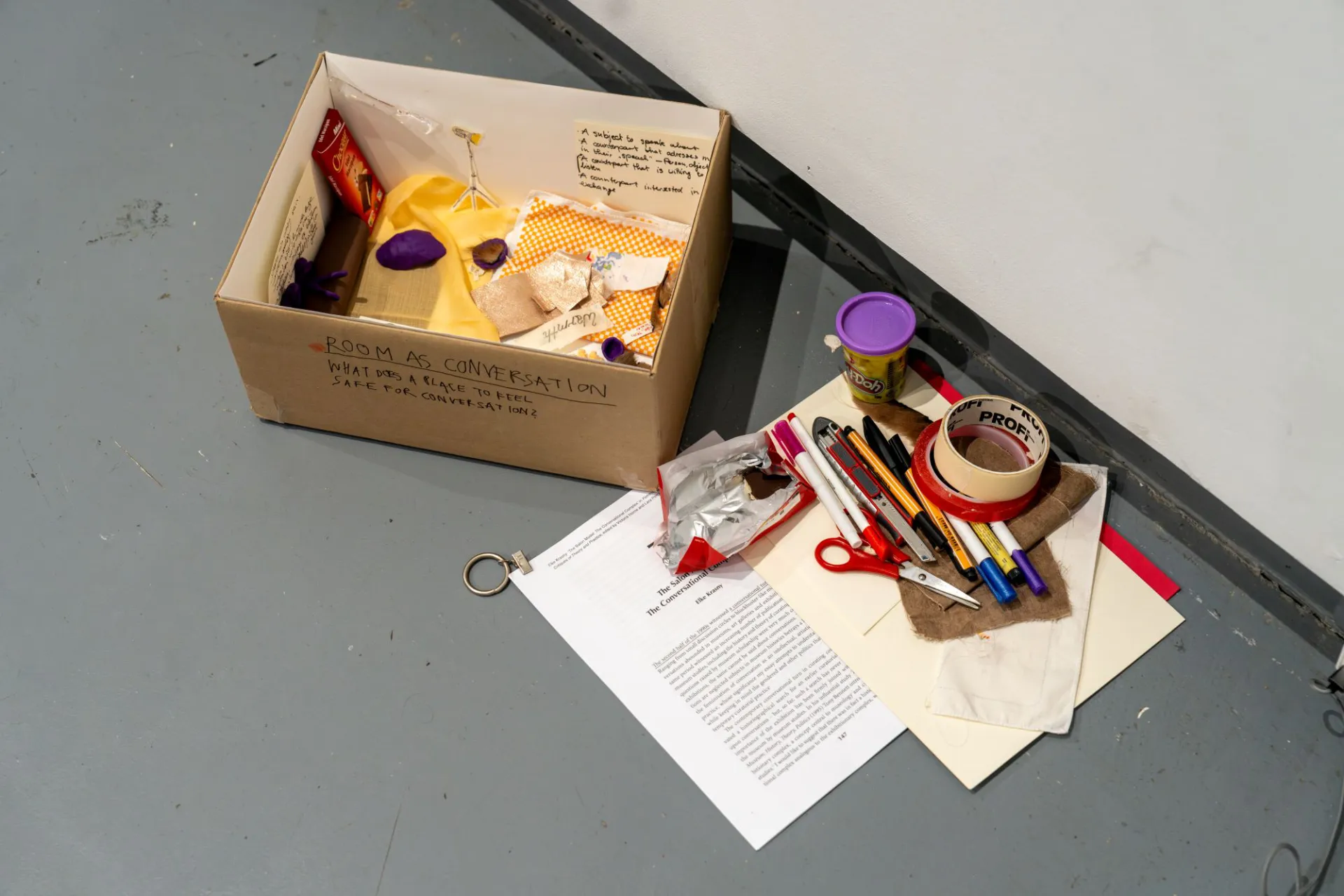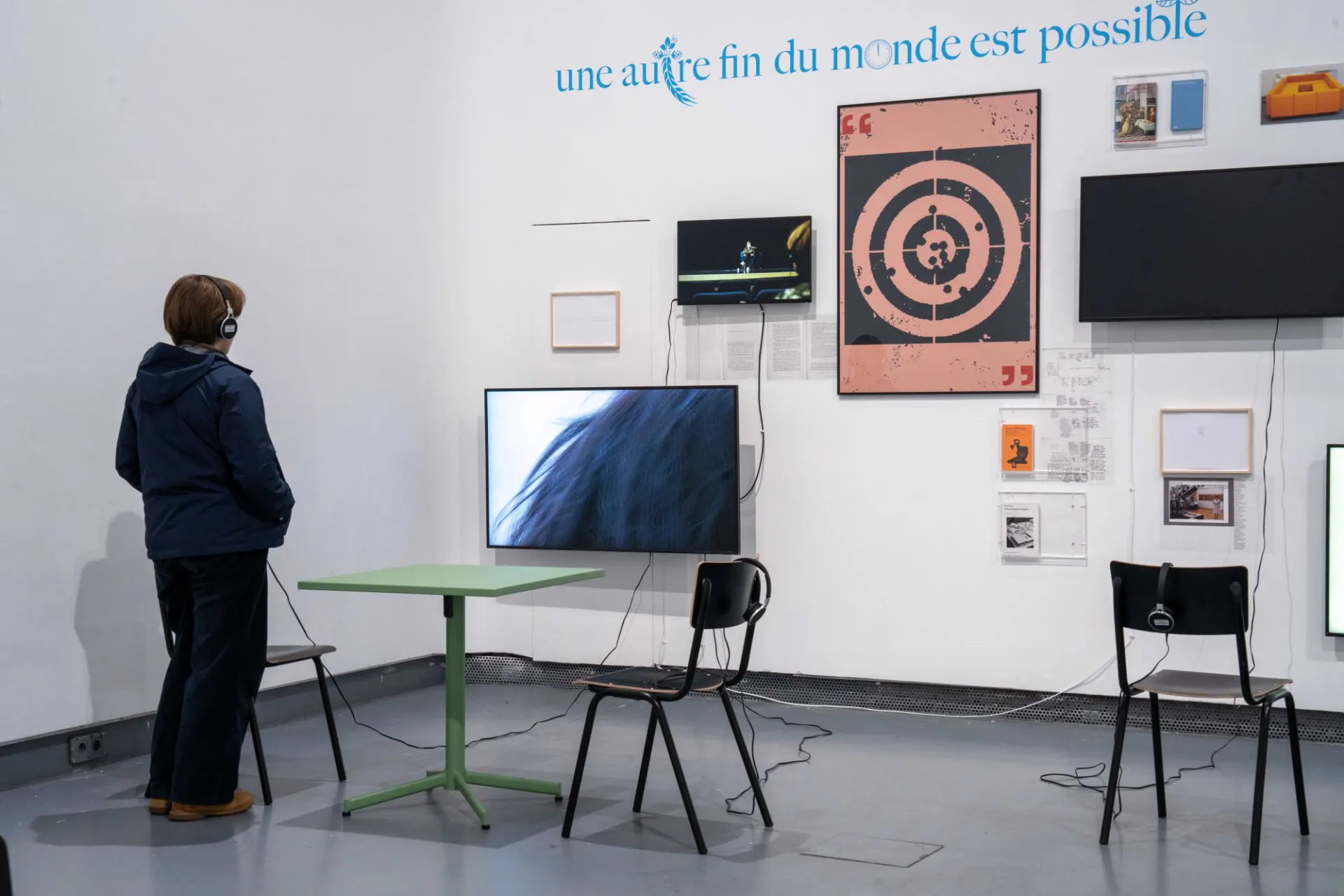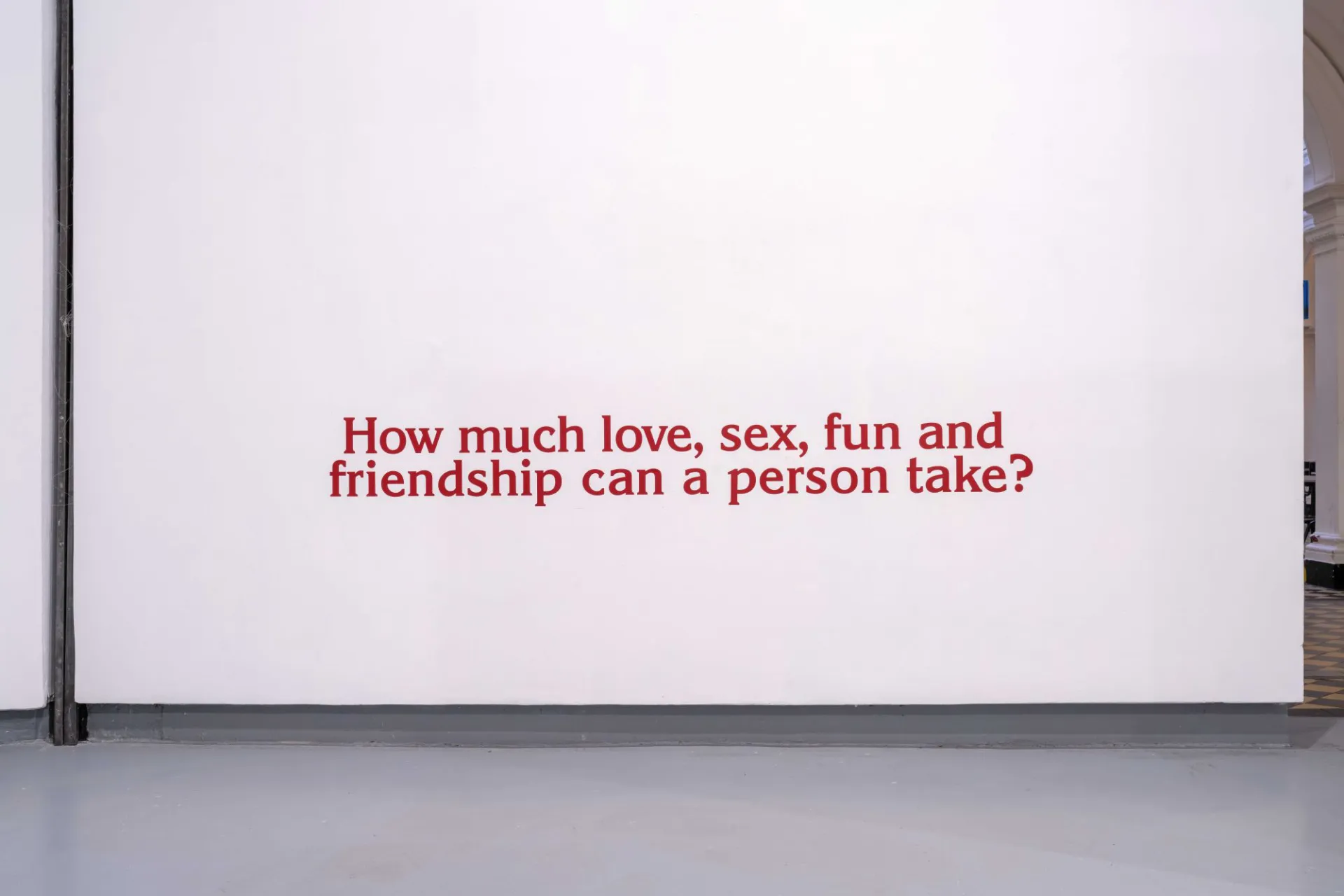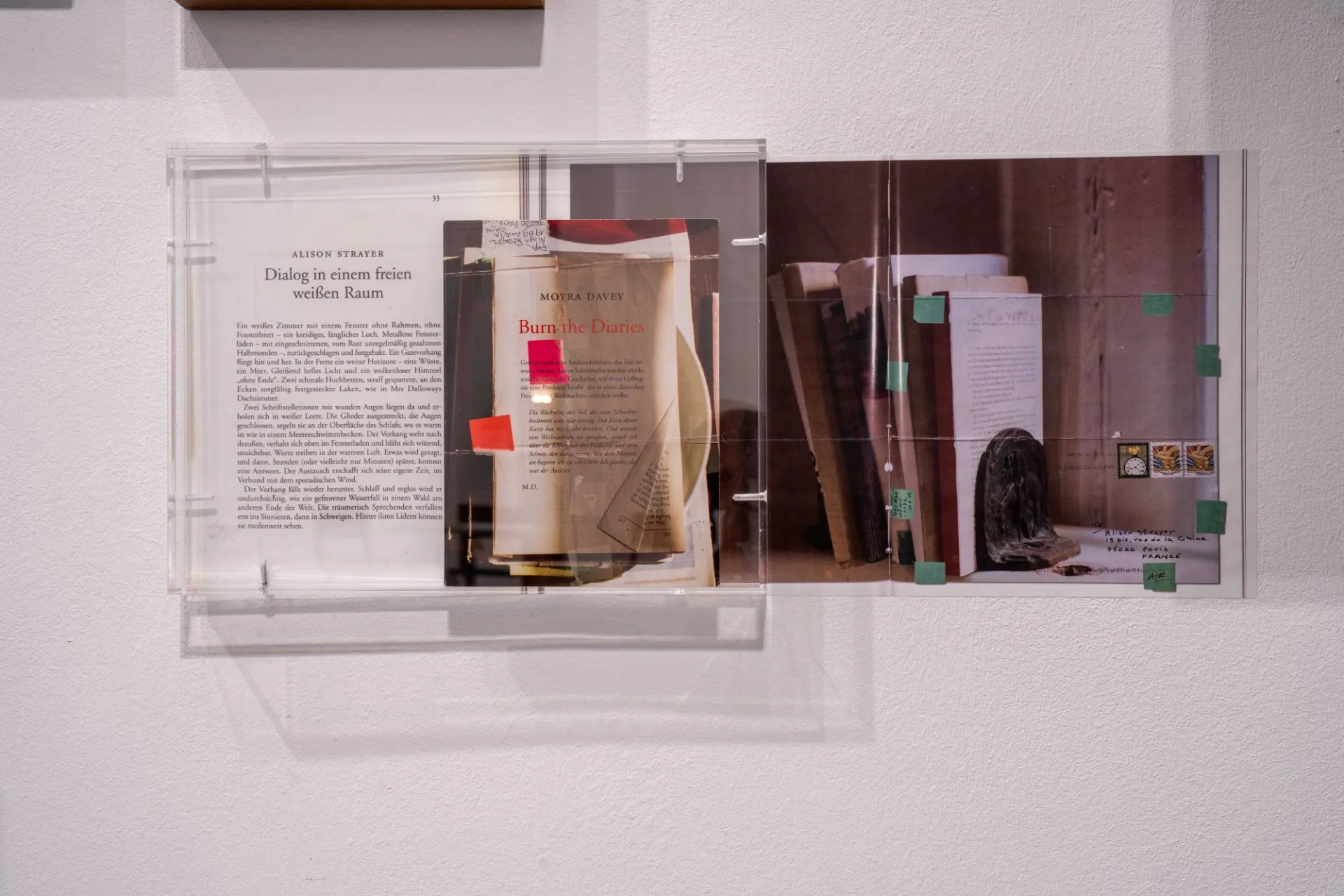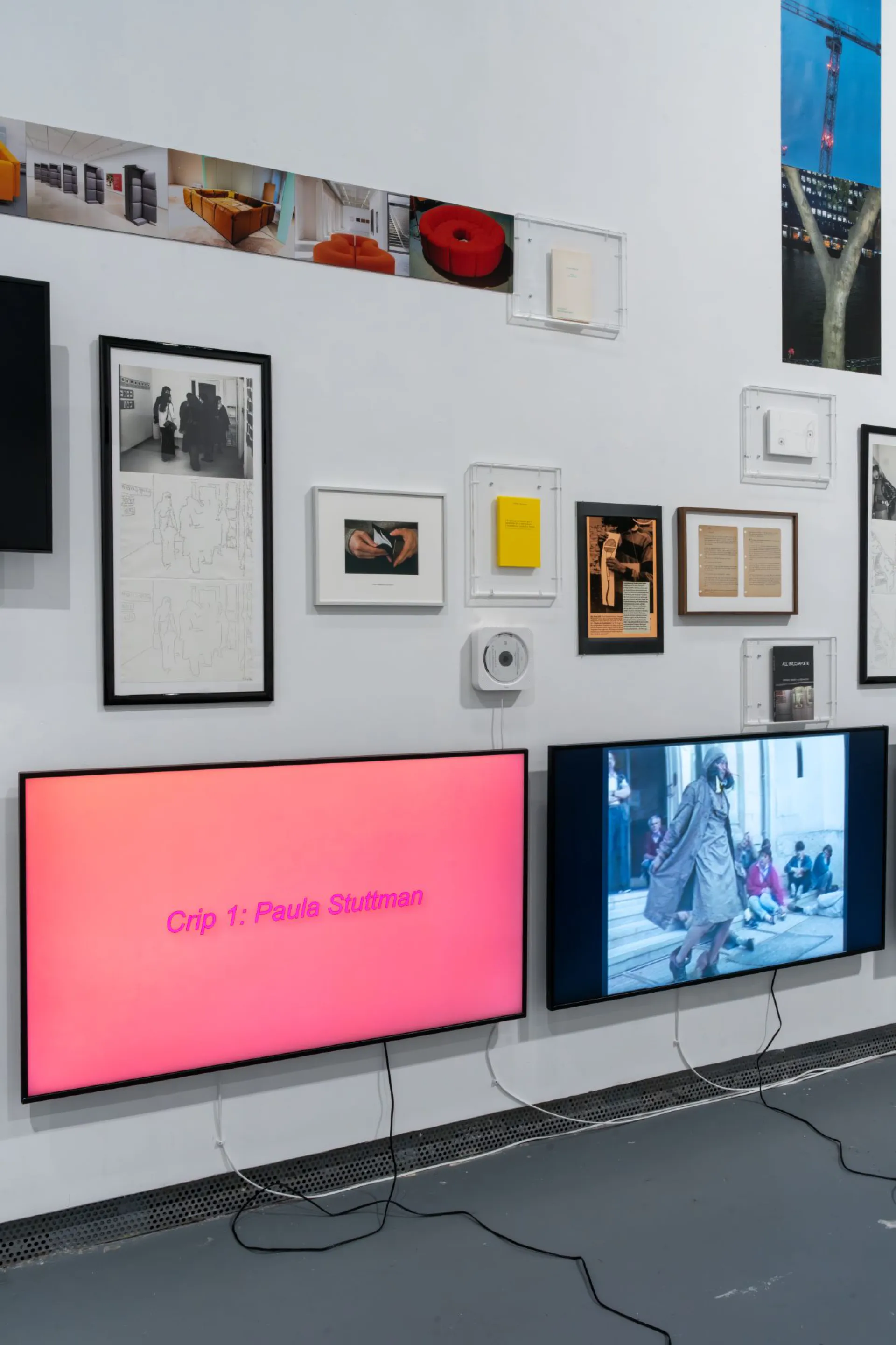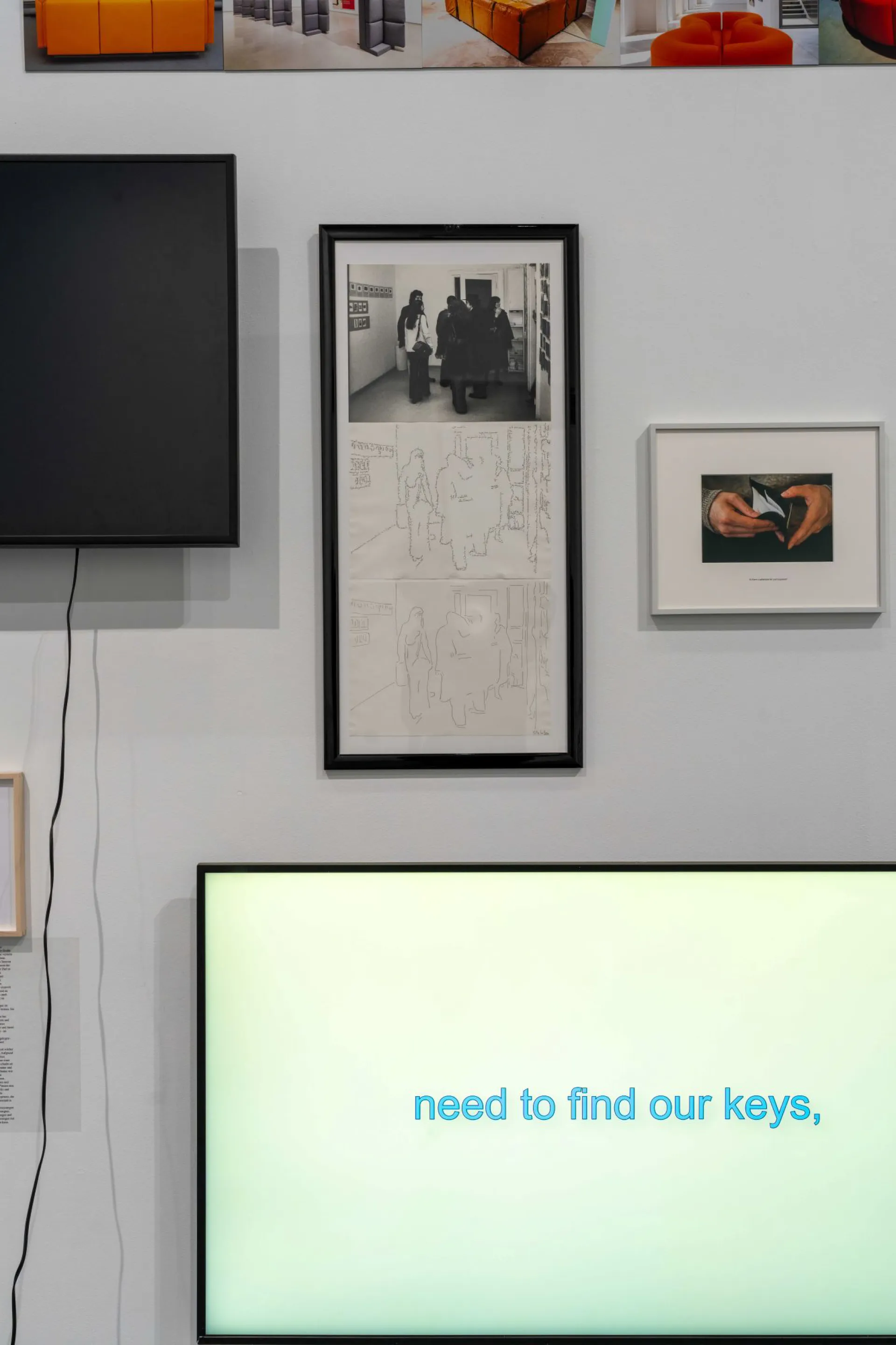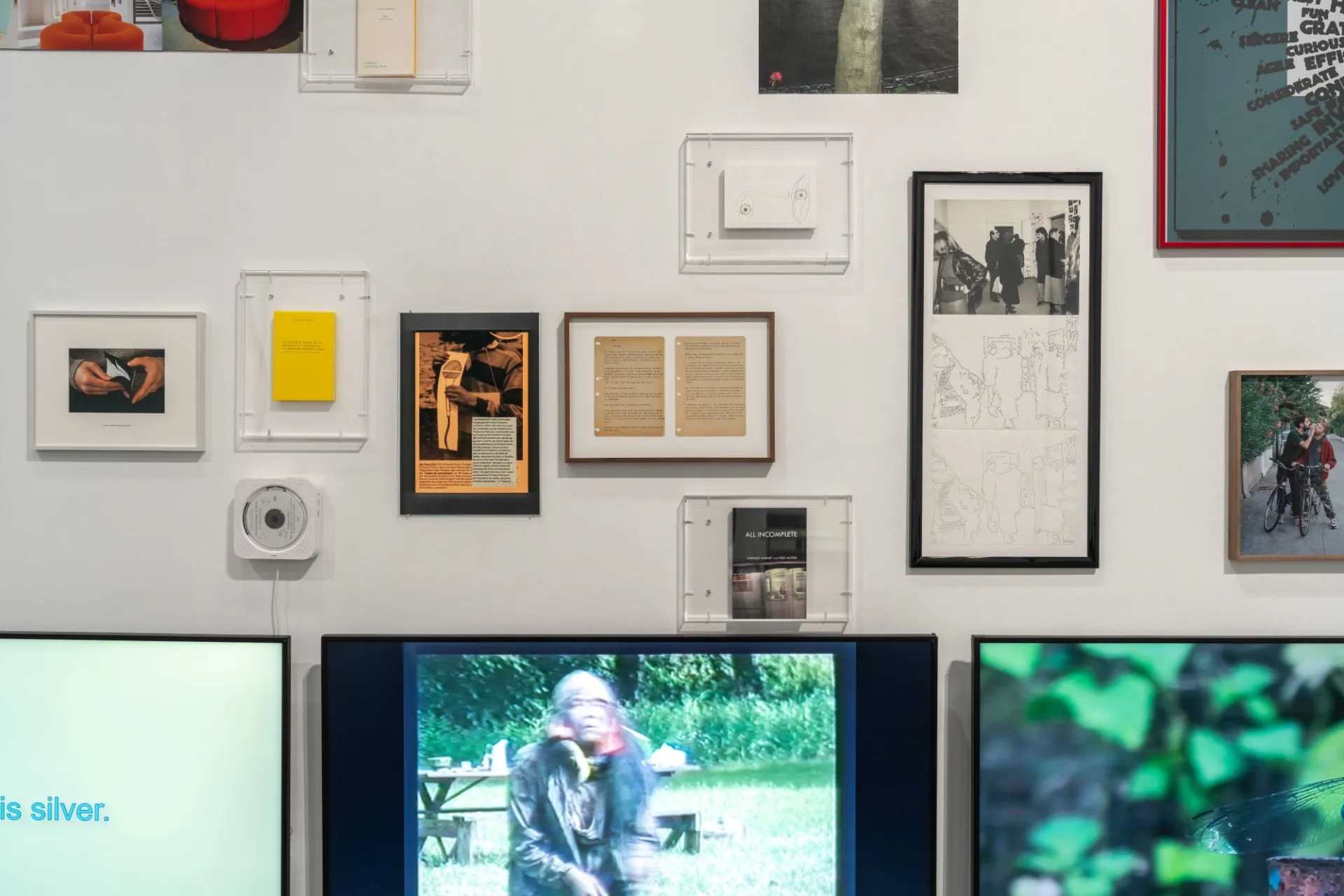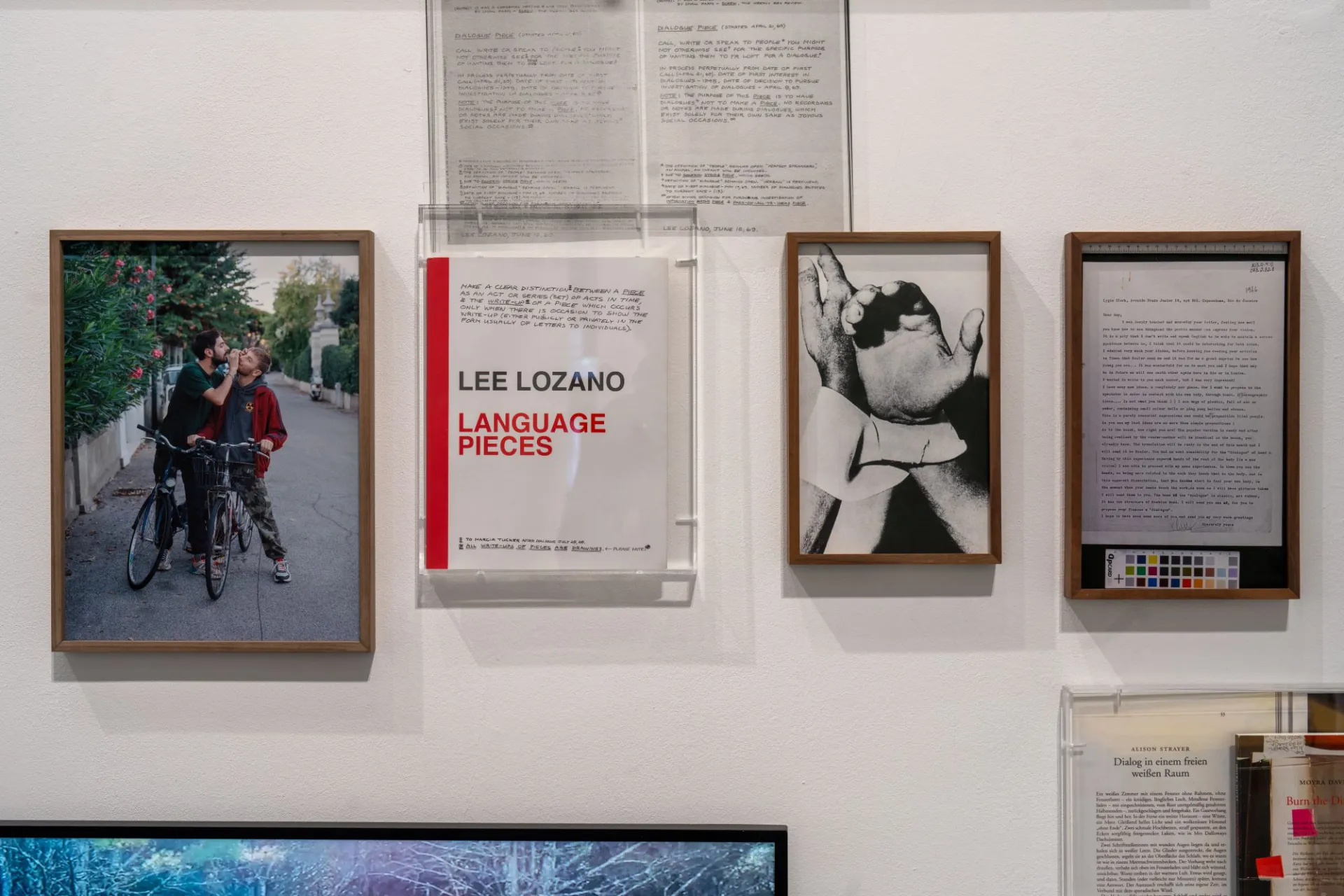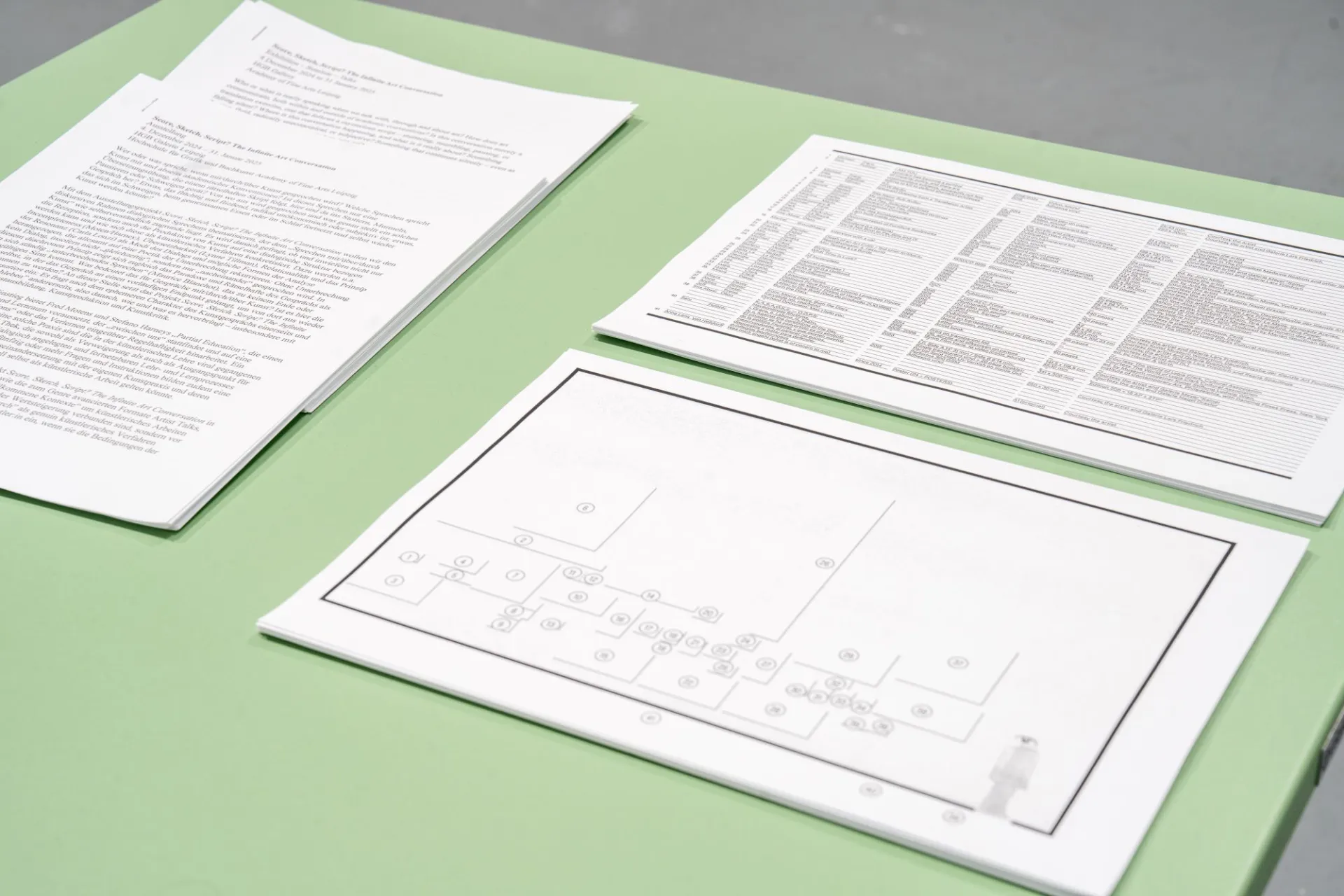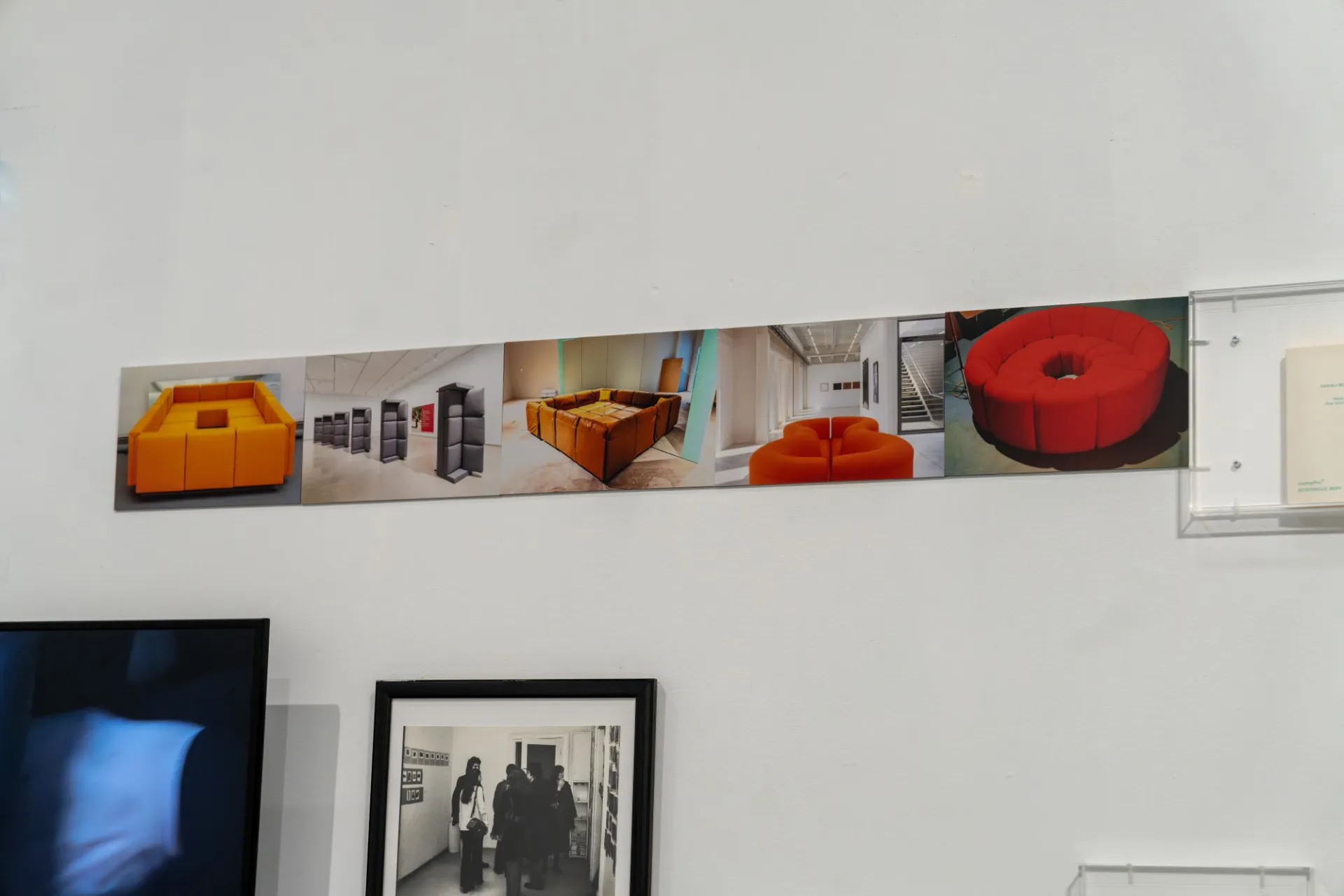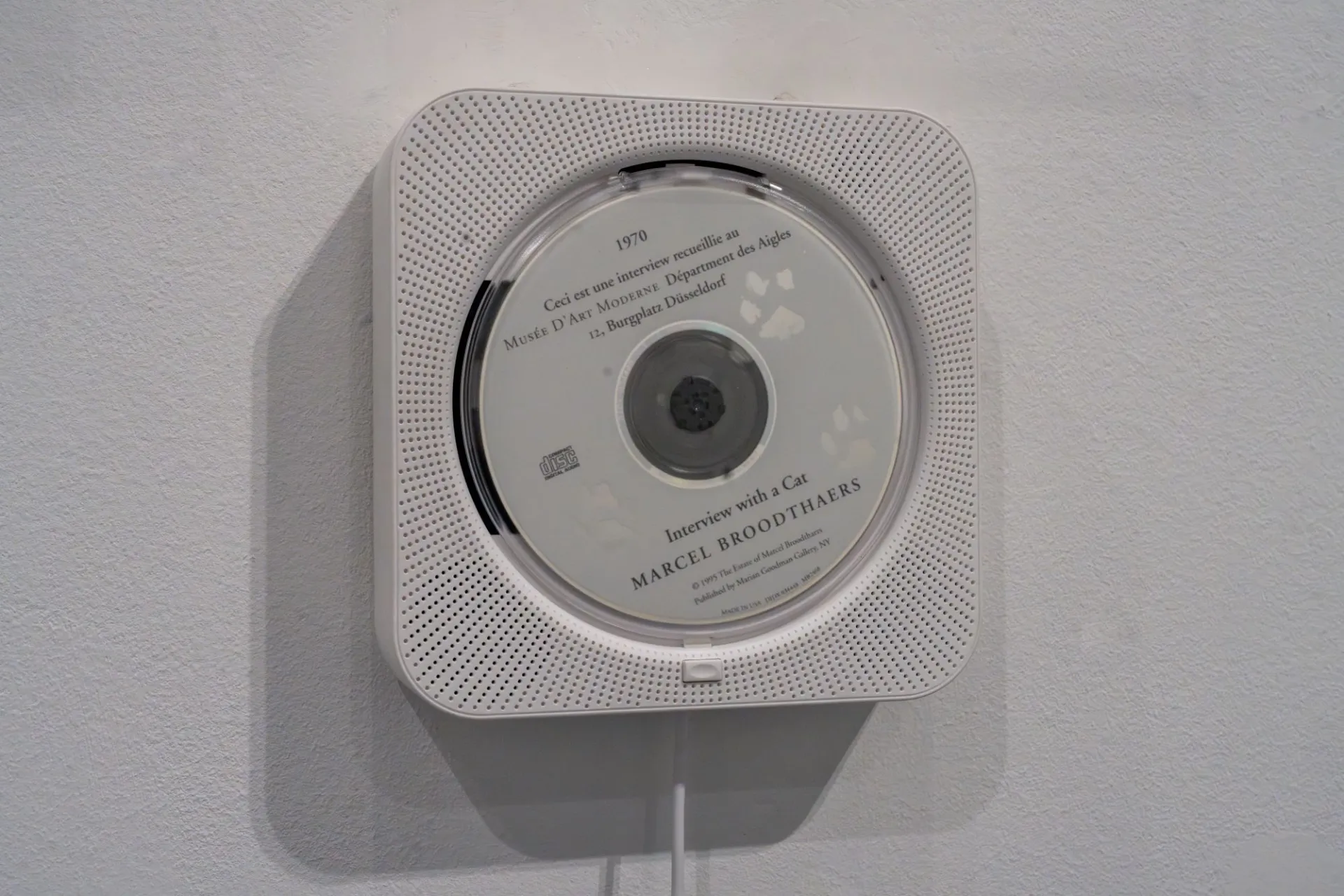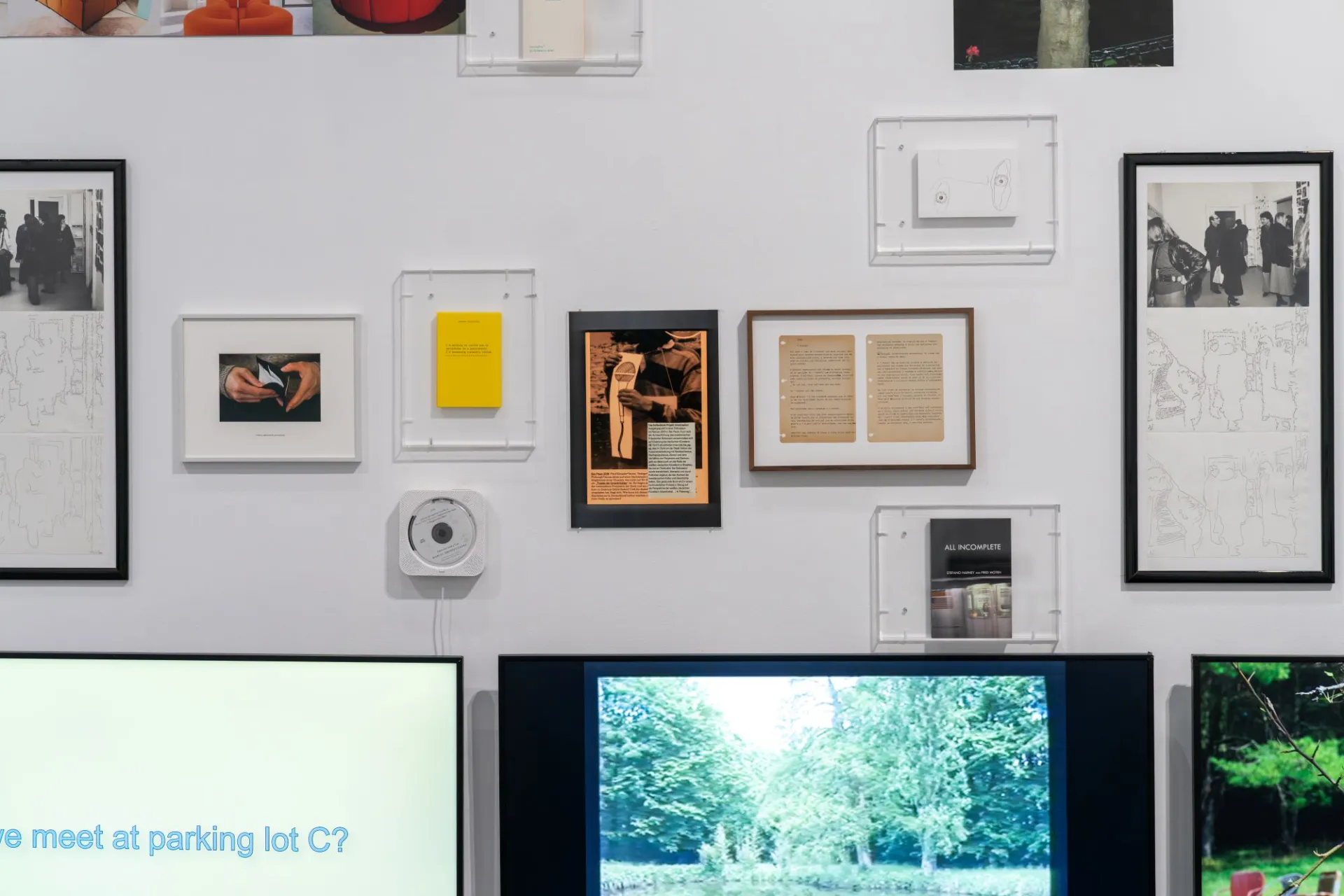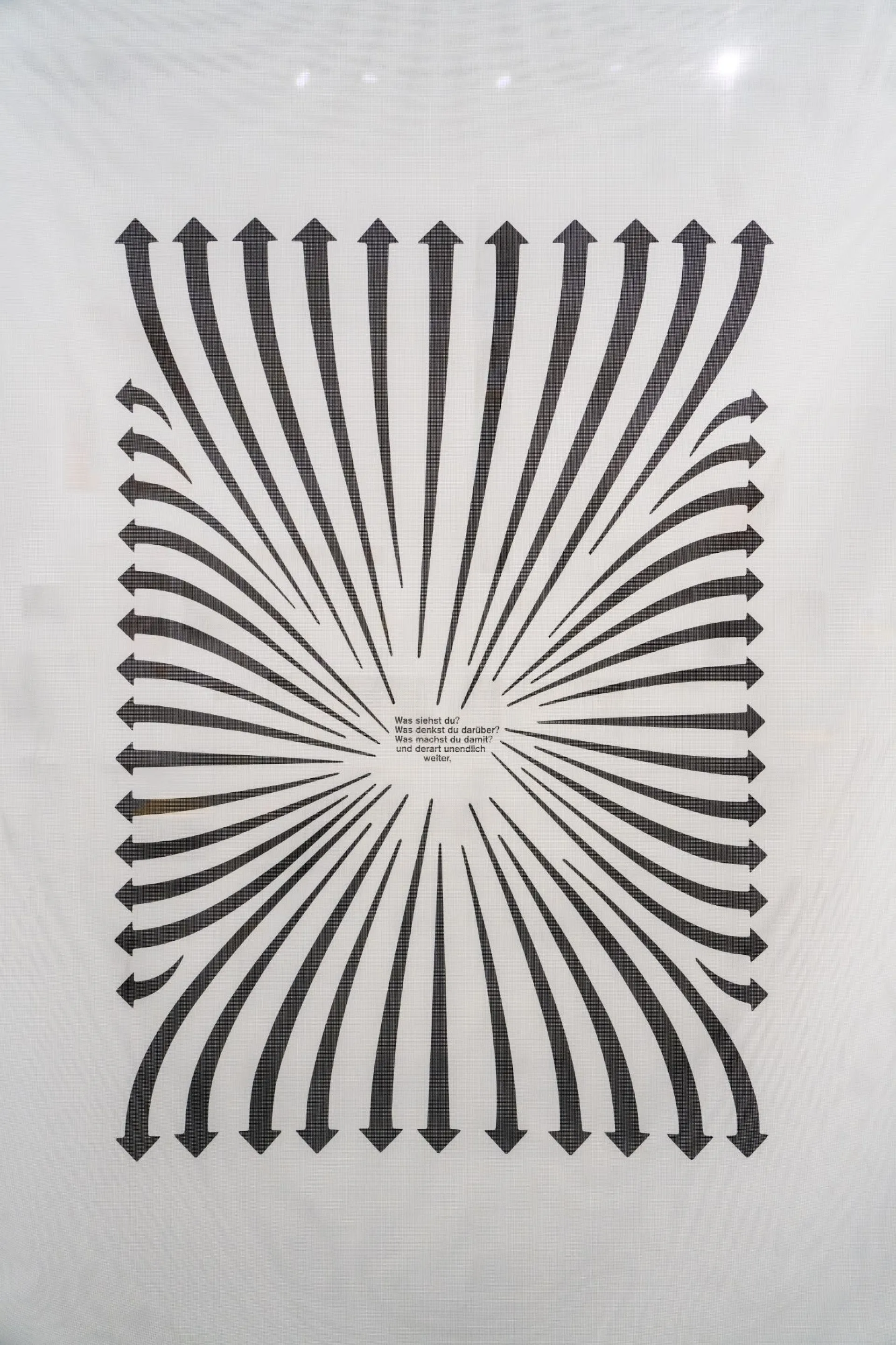Score, Sketch, Script? The Infinite Art Conversation (12.12.2024–30.01.2025)
Who or what speaks when art is spoken with/through/about? What languages does art speak with and beyond academic conventions? Is this speaking merely a translation exercise that follows an enigmatic script, stuttering, mumbling, pausing or falling silent here and there? From where is it spoken and what exactly does such a conversation produce? Something that is fleeting and flowing, radically uneconomical or subjective; something that continues in silence, while eating together or sleeping and could itself become art again?
The exhibition project "Score, Sketch, Script? The Infinite Art Conversation" at the HGB Gallery addresses the discursive and prescriptively fixed framework of dialogical speech that is the natural basis for "speaking with/about/through art". It asks whether and to what extent not only the reception but also the production of art can be related to a dialogical structure and how this is concretised as an artistic process. Incompleteness (Moten/Harney), translatability (Lynne Tillman), relationality and the principle of resonance (Carla Lonzi) are used as modes of dialogue and possible forms of analysis, all of which refer to a poetics of interruption: Without interruption, there is no dialogue, insofar as people do not speak "simultaneously" but only "successively". This diachronic principle also reveals the paradoxical and enigmatic nature of dialogue as a constantly "interrupting speech" (Maurice Blanchot) that never comes to an end or ultimate meaning. What does this mean for conversations with/through/about art? Is it the art itself in which the conversation reaches a temporary end point in order to be taken up again from there? This is where the project "Score, Sketch, Script? The Infinite Art Conversation" begins at this point: it enquires into the ephemeral character of the art conversation on the one hand and its "afterlife" on the other, i.e. how and what it produces - in particular with reference to art education (1), art production (2) and art criticism (3).
(1) Fred Moten and Stefano Harney's concept/idea of "partial education", which presupposes a processual thinking and learning space that takes place "between us" and works towards a "perversion of instructions" or the unlearning of practised regularity, offers a possible starting point. A historical example of such a practice are the "Teaching Notes" by the artist Paul Thek, which went viral in artistic teaching and can be read both as a refusal and as a starting point for an incomplete teaching and learning process that can be continued because it is based on dialogue. Thek's fifty or more questions and instructions also form a kind of script for a dialogue-based examination of his own art practice and its situatedness - a script that could potentially be considered an artistic work itself.
(2) The project "Score, Sketch, Script? The Infinite Art Conversation" focusses on this turning point by asking less about how the formats of artist talks, artist lectures or artist writings, which have become genres, construct "(un)welcome contexts" around artistic work.The question is not only how the formats of artist talks, artist lectures or artist writings, which have become a genre, construct "(un)welcome contexts" around artistic work that are simultaneously linked to logics of value enhancement, but above all how this "speaking with/about/through" is used as a genuinely artistic process. What position does an artist take when reflecting on the conditions of their own artistic work? Is this based on an (imagined) dialogue-based relationship to the "object"? And when does speaking about/with/through oneself become the subject of artistic production? What role is assigned to the body or the relationship between seeing/showing and speaking? Is this speaking connected with haptic seeing or with the dimension of touching and non-verbal communication? Questions such as these are thematised in the exhibition through discussions "with" the artistic works, particularly against the background of media translation processes.
(3) However, the retrospective "talking about" is also negotiated with regard to the methodological intersections of artistic practices and art criticism (including polyphonic collages, imagined conversations, multiplication of the speaker's position). Here, the project is orientated towards performative, polyphonic or situated forms of speaking/writing that are at odds with the objectification tendencies inherent in art criticism. In this context, feminist art criticism is of interest, as are dialogical forms of speculative narration that sensitise us to the question of who speaks from where and how.
In "Score, Sketch, Script? The Infinite Art Conversation", the aforementioned themes are combined into an open exhibition form in which the unfinished is the programme: it continues through public screenings and talks, a series of discussions, seminars and workshops. The vertically structured "Exhibitionary Complex" (Tony Bennett) will be problematised and transformed in relation to the horizontally structured "Conversational Complex" (Elke Krasny). In the conception of this project, we also ask how this form of exhibiting, developed from the feminist salon model, must be conceived differently: On the one hand, it refers to privileged spaces for dialogue; on the other hand, its conditions have changed with the infrastructures of new technologies.
What is dialogue other than the constant negotiation of its conditions, its framework? And for what purpose? To change the framework conditions of dialogue, to test their shifting or stretching capacity? Are there power effects that can be uncovered or even realised differently when the well-rehearsed dividing lines between art and art dialogue, art and discourse, as well as their sometimes questionable mutual support and representation function are called into question? "It's almost like it is your responsibility to engage in responder-ship - not because you know about it, but because you can." (Amy Sillman)
Talks:
09 January, 17:30
Tanja Widmann, visual artist and professor of art education at the Academy of Fine Arts Munich
16 January, 17:30
Amanda Carneiro, historian, curator and publicist
23 January, 15:30
Sabeth Buchmann, art historian and critic, Professor of Art History at the Academy of Fine Arts Vienna
30 January, 17:30
Eleanor Ivory Weber, visual artist and lecturer in art theory and critical practice at the École de recherche graphique Brussels
(1) Fred Moten and Stefano Harney's concept/idea of "partial education", which presupposes a processual thinking and learning space that takes place "between us" and works towards a "perversion of instructions" or the unlearning of practised regularity, offers a possible starting point. A historical example of such a practice are the "Teaching Notes" by the artist Paul Thek, which went viral in artistic teaching and can be read both as a refusal and as a starting point for an incomplete teaching and learning process that can be continued because it is based on dialogue. Thek's fifty or more questions and instructions also form a kind of script for a dialogue-based examination of his own art practice and its situatedness - a script that could potentially be considered an artistic work itself.
(2) The project "Score, Sketch, Script? The Infinite Art Conversation" focusses on this turning point by asking less about how the formats of artist talks, artist lectures or artist writings, which have become genres, construct "(un)welcome contexts" around artistic work.The question is not only how the formats of artist talks, artist lectures or artist writings, which have become a genre, construct "(un)welcome contexts" around artistic work that are simultaneously linked to logics of value enhancement, but above all how this "speaking with/about/through" is used as a genuinely artistic process. What position does an artist take when reflecting on the conditions of their own artistic work? Is this based on an (imagined) dialogue-based relationship to the "object"? And when does speaking about/with/through oneself become the subject of artistic production? What role is assigned to the body or the relationship between seeing/showing and speaking? Is this speaking connected with haptic seeing or with the dimension of touching and non-verbal communication? Questions such as these are thematised in the exhibition through discussions "with" the artistic works, particularly against the background of media translation processes.
(3) However, the retrospective "talking about" is also negotiated with regard to the methodological intersections of artistic practices and art criticism (including polyphonic collages, imagined conversations, multiplication of the speaker's position). Here, the project is orientated towards performative, polyphonic or situated forms of speaking/writing that are at odds with the objectification tendencies inherent in art criticism. In this context, feminist art criticism is of interest, as are dialogical forms of speculative narration that sensitise us to the question of who speaks from where and how.
In "Score, Sketch, Script? The Infinite Art Conversation", the aforementioned themes are combined into an open exhibition form in which the unfinished is the programme: it continues through public screenings and talks, a series of discussions, seminars and workshops. The vertically structured "Exhibitionary Complex" (Tony Bennett) will be problematised and transformed in relation to the horizontally structured "Conversational Complex" (Elke Krasny). In the conception of this project, we also ask how this form of exhibiting, developed from the feminist salon model, must be conceived differently: On the one hand, it refers to privileged spaces for dialogue; on the other hand, its conditions have changed with the infrastructures of new technologies.
What is dialogue other than the constant negotiation of its conditions, its framework? And for what purpose? To change the framework conditions of dialogue, to test their shifting or stretching capacity? Are there power effects that can be uncovered or even realised differently when the well-rehearsed dividing lines between art and art dialogue, art and discourse, as well as their sometimes questionable mutual support and representation function are called into question? "It's almost like it is your responsibility to engage in responder-ship - not because you know about it, but because you can." (Amy Sillman)
Talks:
09 January, 17:30
Tanja Widmann, visual artist and professor of art education at the Academy of Fine Arts Munich
16 January, 17:30
Amanda Carneiro, historian, curator and publicist
23 January, 15:30
Sabeth Buchmann, art historian and critic, Professor of Art History at the Academy of Fine Arts Vienna
30 January, 17:30
Eleanor Ivory Weber, visual artist and lecturer in art theory and critical practice at the École de recherche graphique Brussels
